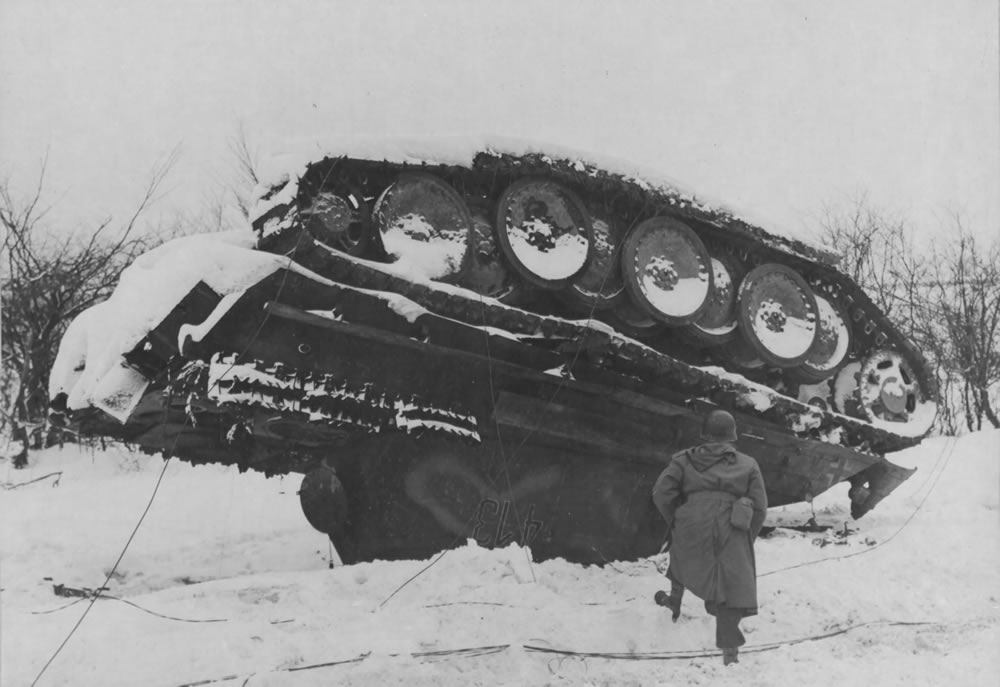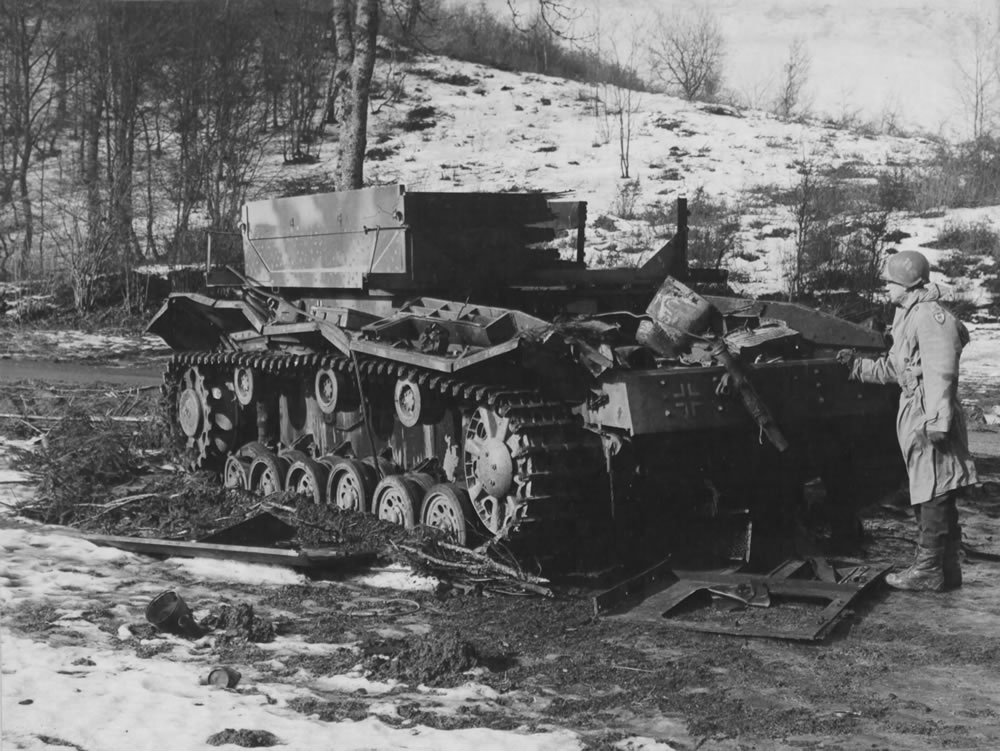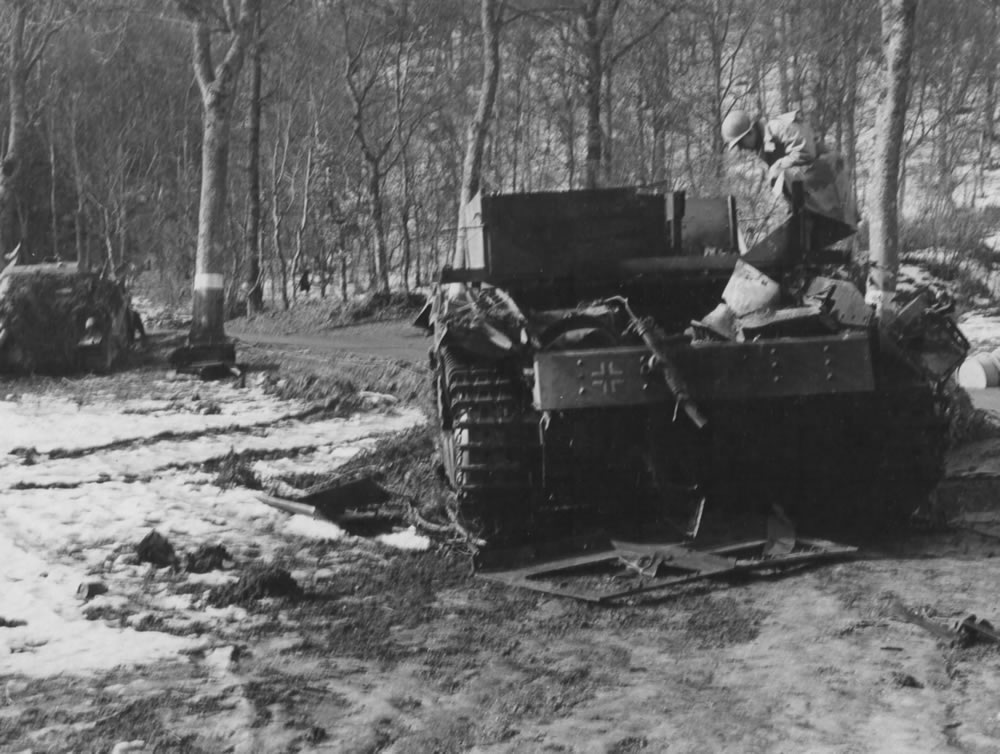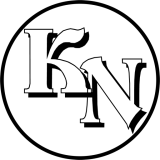Tank Maintenance in the Ardennes Offensive
- 1. When did you first know of the plans for the Ardennes Offensive?
- 2. Just what was the organization of these tank repair companies and how far behind the lines did you locate them?
- 3. Did our air raids interfere greatly with the work of your repair units?
- 4. About how many tanks did you have in the Ardennes Offensive at its start?
- 5. What was the relationship of Von Rundstedt to Model in this attack?
- 6. What was the fuel situation at the time of the attack?
- 7. It has been reported that the only person in your army who received new tanks during the offensive was Oberst Otto Remer who commanded the Fuehrer Escort Brigade. Is this true?
- 8. Were you able to withdraw most of your tanks from the Bulge?
An oral interview with General der Panzertruppe Horst Stumpff, August 1945
General der Panzertruppe Horst Stumpff (1887 – 1958), was a very experienced officer, who had earned his reputation during the Polish-, French- and Russian campaigns. In July 1944 he became the Inspector General of the Panzer troops in the replacement army. In this capacity he worked directly under Generaloberst Guderian. In December 1944 Stumpff was assigned to Generalfeldmarschall von Rundstedt’s staff (OB West) as Chief Armored Officer. As von Rundstedt, while directing the German field forces in the Ardennes Offensive, was not directly concerned with the planning for the attack, General der Panzertruppe Stumpff’s knowledge of this phase of the offensive was quite limited.

Capt. James R. Lloyd, a 9th AF Air Liaison officer, examines a Panther tank, outside Houffalize, Belgium, an area thoroughly bombed and strated by 9th AF fighter-bombers during the German advance and withdrawal. Capt. Lloyd co-ordinated fighter-bombers attacks ahead of the 82nd Airborne Div. in the Ardennes fighting. He was a member of the 370th Lockheed P-38 Lightning Group. (US Air Force)
1. When did you first know of the plans for the Ardennes Offensive?
STUMPFF: I learned of the plans very late because the offensive was supposed to be a secret. On 13 December 44, I heard of the attack by chance; shortly thereafter, I was officially informed of my role in the offensive. My major task was to bring all repair shops into the Eifel in order that we might provide rapid servicing for the damaged tanks. On about 14 or 15 December 1944, I began bringing up my shops into the attack area.
2. Just what was the organization of these tank repair companies and how far behind the lines did you locate them?
STUMPFF: Altogether, we had six repair companies which perform what you call third and fourth echelon repair work; in addition, we had one evacuation company. Two of these companies were pushed rather far forward, one near Clerf and the other near St. Vith. In the withdrawal phase, these companies actually were working under your artillery fire. Because of the difficulties involved in moving these companies, they were not shifted forward with the attacking units.
3. Did our air raids interfere greatly with the work of your repair units?
STUMPFF: No. As we generally located our units away from towns and road junctions, they were not bothered much by your air force.

A German Bergepanzer III armoured recovery vehicle knocked out near the Seigfried Line in an area subjected to heavy fighter-bomber attack by other USAF planes. A 9th AF pilot is shown inspecting the vehicle, abandoned beside a road near Hosingen. (US Air Force)
4. About how many tanks did you have in the Ardennes Offensive at its start?
STUMPFF: I cannot give you a definite answer to that question; however, I can tell you that we had a total of about 1800 tanks in Army Group B, that is, from the Aachen area to Trier.
5. What was the relationship of Von Rundstedt to Model in this attack?
STUMPFF: Generalfeldmarschall von Rundstedt issued the orders for movement of troops in the attack, but Model was the commander and was in charge of the planning before and during the attack.
6. What was the fuel situation at the time of the attack?
STUMPFF: To begin with, we had enough gasoline to carry us a considerable distance. We had three consumption units per tank (Interviewer’s note: a consumption unit is equivalent to 50-60 km in distance). Most of the fuel reserves, however, were located along the Rhine River, and, once it snowed, could not be brought up because of the intolerable road conditions. For this reason, we could only use a small number of the tanks available to us, and, in addition, lost many of our tanks through lack of fuel; however, our plans did not contemplate the use of captured gasoline.
Another great difficulty was the lack of spare parts. This, of course, had been a problem for us for some time, but it became extremely acute during the Ardennes Offensive. At one time, we did get reserves of new tanks, but rather than use gasoline to run them to the front, we disassembled these tanks and used the spare parts to repair the tanks then in echelon repair. These new tanks had been brought to an area 40 km west of Koblenz.

Two German armored vehicles (a Bergepanzer III armoured recovery vehicle and a Jagdpanzer 38 tank-destroyer) litter a roadside west of Hosingen, near the Seigfried Line, a sector repeatedly strafed and bombed by 9th AF fighter-bomber planes. A 9th AF pilot is shown clambering over one of the disabled vehicles. (US Air Force)
7. It has been reported that the only person in your army who received new tanks during the offensive was Oberst Otto Remer who commanded the Fuehrer Escort Brigade. Is this true?
STUMPFF: It is true that Remer got some new tanks during the attack, but he was not the only one. The number of new tanks sent up, however, was very small due to the facts I have explained.
8. Were you able to withdraw most of your tanks from the Bulge?
STUMPFF: We had great difficulties in getting our tanks out of the Ardennes area after the attack had failed. In the first place, a large number of the evacuation vehicles had been destroyed by your air force and, in addition, the road conditions made evacuation extremely difficult. When we were withdrawing, naturally every effort was made to bring the tanks back, but it was very difficult. Sometimes our engineers blew up bridges behind us and we were forced to abandon large numbers of tanks being evacuated over those routes.
Notes: The interrogation was held on 11 August 1945 in 7th US Army Interrogation Center in Hidelberg, Germany. Interviewer: 1st Lt Robert E. Merriam; Interpreter: M/Sgt Werner Lehnberg.
Source: NARA, Foreign Military Studies, ETHINT-61 “Tank maintenance in the Ardennes Offensive”.
